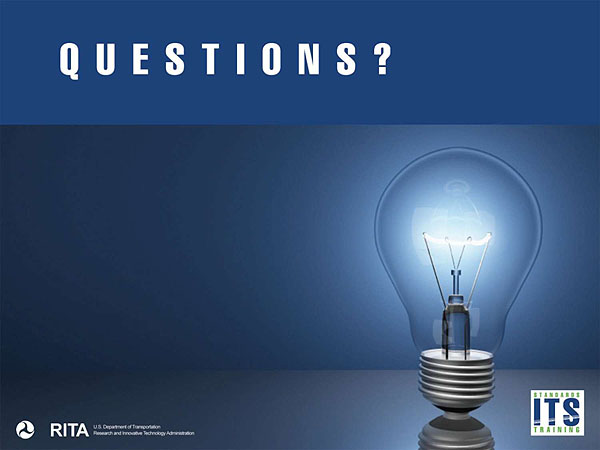Module 13 - T202
T202: Overview of Test Design Specifications Test Cases, and Test Procedures
HTML of the PowerPoint Presentation
(Note: This document has been converted from a PowerPoint presentation to 508-compliant HTML. The formatting has been adjusted for 508 compliance, but all the original text content is included, plus additional text descriptions for the images, photos and/or diagrams have been provided below.)
Slide 1:

(Extended Text Description: Slide 1: Welcome - Graphic image of introductory slide. A large dark blue rectangle with a wide, light grid pattern at the top half and bands of dark and lighter blue bands below. There is a white square ITS logo box with words “Standards ITS Training” in green and blue on the middle left side. The word “Welcome” in white is to the right of the logo. Under the logo box are the words “RITA Intelligent Transportation Systems Joint Program Office.”)
Slide 2:
Welcome

Shelley Row, P.E., PTOE
Director
ITS Joint Program Office

(Extended Text Description: Slide 2: Screen capture snapshot of RITA website - for illustration only. Below this image is a link to the current website: https://www.its.dot.gov/pcb - this screen capture snapshot shows an example from the RITA website from June 3, 2011. At the top of the page it shows the RITA logo with the text Research and Innovative Technology Administration - Intelligent Transportation Systems. Below the main site banner, it shows the main navigation menu with the following items: About RITA, Communities of Interest, Contact Us, Press Room, RITA Offices, Site Map, and a Search button. Below the main navigation menu, it shows a sub-navigation menu with the following items: About Us, T3 Webinars, ITS Peer-to-Peer, Resources, Local ITS PCB and Testimonials. Beneath the sub-navigation menu, the page is sub-titled "ITS Professional Capacity Building Program" and is divided into sub-sections such as "Welcome to ITS Professional Building", "News", "ITS Technical Assistance" and "Scheduled T3 Webinars". Again, this image serves for illustration only. The current website link is: https://www.its.dot.gov/pcb)
(Note: There is additional text attached to this slide that includes the following introductory information from Shelley Row):
"ITS Standards can make your life easier. Your procurements will go more smoothly and you’ll encourage competition, but only if you know how to write them into your specifications and test them. This module is one in a series that covers practical applications for acquiring and testing standards-based ITS systems.
I am Shelley Row the director of the ITS Joint Program Office for USDOT and I want to welcome you to our newly redesigned ITS standards training program of which this module is a part. We are pleased to be working with our partner, the Institute of Transportation Engineers, to deliver this new approach to training that combines web based modules with instructor interaction to bring the latest in ITS learning to busy professionals like you.
This combined approach allows interested professionals to schedule training at your convenience, without the need to travel. After you complete this training, we hope that you will tell colleagues and customers about the latest ITS standards and encourage them to take advantage of the archived version of the webinars.
ITS Standards training is one of the first offerings of our updated Professional Capacity Training Program. Through the PCB program we prepare professionals to adopt proven and emerging ITS technologies that will make surface transportation safer, smarter and greener which improves livability for us all. You can find information on additional modules and training programs on our web site ITS PCB Home.
Please help us make even more improvements to our training modules through the evaluation process. We look forward to hearing your comments. Thank you for participating and we hope you find this module helpful."
Slide 3:
T202
Overview of Test Design Specifications, Test Cases, and Test Procedures
Slide 4:
Target Audience
- Engineering Staff
- Operational Staff
- Maintenance Staff
- Testing Staff (testing personnel and systems integrators, with specialized capabilities)
Slide 5:
Instructor

Russ Brookshire
Product Manager Intelligent Devices
Suwanee,GA
USA
Slide 6:
Recommended Prerequisites
- T101: Introduction to ITS Standards Testing
- T201: How to Write a Test Plan
Slide 7:
Curriculum Path (Testing)
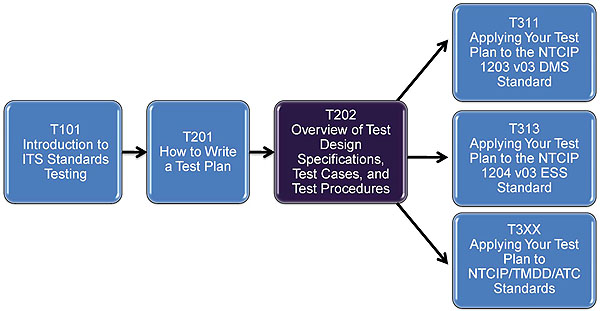
(Extended Text Description: Slide 7: Curriculum Path (Testing): A graphical illustration indicating the sequence of training modules for the standards that include Testing content. Each module is represented by a box with the name of the module in it and an arrow showing the logical flow of the modules. The current module is highlighted. The first box is labeled “T101 Introduction to ITS Standards Testing.” An arrow from this box connects it to a box labeled “T201 How to Write a Test Plan”. An arrow from this box connects it to a highlighted box labeled “T202 Overview of Test Design Specifications, Test Cases, and Test Procedures”, representing this module. Three arrows from this box connect to three additional boxes labeled “T311 Applying Your Test Plan to the NTCIP 1203 v03 DMS Standard”, “T313 Applying Your Test Plan to the NTCIP 1204 v03 ESS Standard”, and “T3XX Applying Your Test Plan to NTCIP/TMDD/ATC Standards”. )
Slide 8:
Learning Objectives
1. Describe, within the context of the testing lifecycle, the role of Test Plans, Test Design Specifications, Test Cases and Test Procedures
2. Describe the purpose and content of Test Design Specifications, Test Cases, and Test Procedures
Slide 9:
Learning Objectives (Cont'd)
3. For standards using the Systems Engineering Process (SEP), detail the manner that Protocol Requirements Lists (PRLs) and Requirements to Test Cases Traceability Matrices (RTCTMs) can be used to create Test Specifications
4. For standards that do not use SEP, detail the manner that Conformance Groups can be used to create Test Specifications
Slide 10:
Learning Objective #1
Testing and the Project Life Cycle
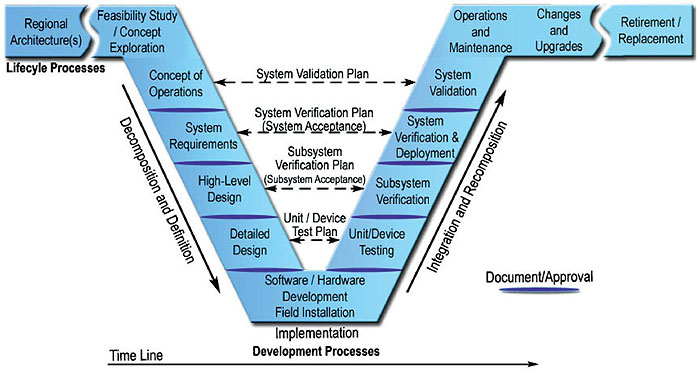
Pages 7 and 8 in the Supplement
(Extended Text Description: Slide 10: A graphic of the FHWA “V” diagram of the Project Life Cycle is shown. The main graphic is a V-shaped diagram with some additional horizontal “wings” on the left and right side of the top of the V. Starting from the left “wing” the steps are Regional Architecture(s) and Feasibility Study / Concept Exploration. At this point the steps begin to descend the left side of the V with: Concept of Operations; System Requirements; High-Level Design; and Detailed Design. The base of the V shows Software / Hardware Development & Field Installation. At this point the steps begin to ascend the right side of the V with: Unit / Device Testing; Subsystem Verification; System Verification & Deployment; and System Validation. Finally, the right “wing” includes steps that occur past the testing phases: Operations and Maintenance; Changes and Upgrades; and Retirement / Replacement. Each phase on the left of the “V” is associated by means of a dashed arrow with a phase on the right “V” (from the bottom): Detailed Design is associated with Unit / Device Testing by the Unit / Device Test Plan; High-Level Design is associated with Subsystem Verification by the Subsystem Verification Plan (Subsystem Acceptance); System Requirements is associated with System Verification & Deployment by the System Verification Plan (System Acceptance); and Concept of Operations is associated with System Validation by the System Validation Plan. The left side of the “V” is labeled “Decomposition and Definition”, the bottom is labeled “Implementation”, and the right side of the “V” is labeled “Integration and Recomposition”. At the bottom, a rightward facing arrow is labeled “Time Line".)
Slide 11:
Learning Objective #1
Why Test?
- To validate the system against the user needs
- To verify compliance with the procurement specifications
- To verify conformance to the standard, ensuring interoperability and interchangeability
Slide 12:
Learning Objective #1
Testing Methods
- Inspection - verification by physical and visual examination
- Analysis - verification by means of calculations
- Demonstration - verification of a function observed under a specific condition
- Formal Testing - verification of a function observed under controlled exercises using real or simulated stimulus
Slide 13:

Slide 14:
What are some of the benefits of NTCIP Conformance Testing?
Enter response in the chat box
Slide 15:
Learning Objective #1
Benefits of Conformance Testing
- Testing for compliance with the project specifications only shows that the system works as specified.
- NTCIP conformance testing promotes interoperability of system elements by means of standardized dialogs, test cases, and test procedures.
- Standardization also reduces overall system cost and risk.
Slide 16:
Learning Objective #1
Test Plans
- Test Plans are defined in IEEE 829, and covered in detail in Module T201 - How to Write a Test Plan
- Typically developed during "Decomposition and Definition" phase of the Project Life Cycle (left-side of "V" diagram); not provided in NTCIP standards
-
Test Plan: high-level document that defines:
- What item is to be tested and when it is to be tested
- In what detail the item is to be tested
- How is the item to be tested
- Who is to design and perform testing
Slide 17:
Learning Objective #1
What Item is to be Tested, and When is it to be Tested
- Unit / Device Test - covers an item and its interfaces
- Subsystem Verification - tests the item, its communications, and other items that communicate with the test item
- System Verification - ensures that the entire system meets the system requirements
- System Validation - used to show that the system as implemented meets the original user needs
Slide 18:
Learning Objective #1
In What Detail is the Item to be Tested
- Communications: serial, Ethernet, packet errors
- Functionality: camera zoom, sign brightness, monitoring of air temperature
- Performance: speed, reliability, capacity
- Hardware: materials, strength, vibration
- Environmental: temperature, humidity, water intrusion, ice buildup
Slide 19:
Learning Objective #1
How is the Item to be Tested?
- NTCIP testing - a combination of communications testing and functional testing
- Communications testing can be performed by NTCIP test software and/or protocol analyzers
- Functional testing may require specialized equipment to simulate testable conditions
- Data that are communicated with the device must correlate at some point with observable behavior, which constitutes the functionality to be tested.
Slide 20:
Learning Objective #1
Who is to Design and Perform the Testing
- Agency personnel, out-of-house expert, manufacturer's representative?
- Note that each have pros and cons
- In many instances, a combination is the answer
Slide 21:
Learning Objective #1
Additional Considerations for Test Plans
- Item Pass/Fail Criteria
- Suspension Criteria and Resumption Requirements
Slide 22:
Learning Objective #2
Test Specifications
- Test Design Specification (TDS) - A document specifying the details of the test approach for a...feature or combination of.. features and identifying the associated tests.
- Test Case Specification (TCS) - A document specifying inputs, predicted results, and a set of execution conditions for a test item.
- Test Procedure Specification (TPS)- A document specifying a sequence of actions for the execution of a test.
Definitions per IEEE 829
Slide 23:
Learning Objective #2
Test Documentation Components

(Extended Text Description: Slide 23: To the left of the text is a graphic showing the relationship of Test Plans and Test Specifications. At the top is a block labeled “Test Plan”, which has a single arrow downward to a block labeled “Test Design Specification”. This block has three arrows pointing to three blocks labeled “Test Case 1”, “Test Case 2”, and “Test Case 3”. Below these three blocks are three blocks labeled “Test Procedure 1”, “Test Procedure 2”, and “Test Procedure 3”. Test Cases 1 and 2 have arrows pointing to Test Procedure 1. Test Case 3 has two arrows: the first points to Test Procedure 2; the second points to Test Procedure 3.)
- Each Test Plan has a Test Design Specification
- Each Test Design Specification may reference multiple Test Case Specifications
- Each Test Case Specification may reference multiple Test Procedure Specifications and vice versa
Slide 24:
Learning Objective #2
Example of Test Specifications
Test Item: Calculator
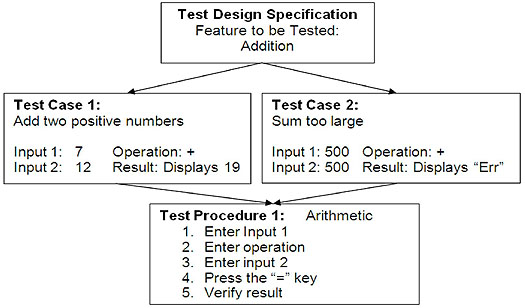
(Extended Text Description: Slide 24: A graphic shows an example of test specification that uses a calculator for the test item. Four text boxes are shown. The top box has the header “Test Design Specification” along with the test “Feature to be Tested: Addition”. This box has two arrows, each leading to a box labeled respectively “Test Case 1” and “Test Case 2”. The Test Case 1 box has the text “Add two position numbers”, with Input 1 being 7, Input 2 being 12, Operation shows a “plus” sign for addition, and Result being “Displays 19”. The Test Case 2 box has the text “Sum too large”, with Input 1 being 500, Input 2 being 500, Operation shows a “plus” sign for addition, and Result being “Displays “Err””. The Test Case 1 and Test Case 2 boxes each have an arrow leading to the final box at the bottom of the slide. This box has a Header “Test Procedure 1: Arithmetic”, followed by the steps: 1. Enter Input 1; 2. Enter operation; 3. Enter input 2; 4. Press the “=” key; 5. Verify result.)
Slide 25:
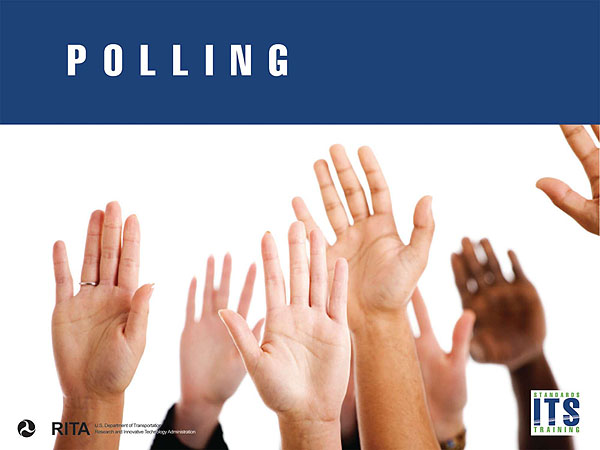
Slide 26:
Which of the following are included in NTCIP standards?
- Test Design Specifications (TDS)
- Test Case Specifications (TCS)
- Test Procedure Specifications (TPS)
- All three
- It depends
Slide 27:
Learning Objectives #1, 2
Summary of Test Documents
- Test Plan - Overview of entire testing process
- Test Design Specification (TDS) - Specifies details of the test approach
- Test Case Specification (TCS) - Specifies inputs, outputs and conditions
- Test Procedure Specification (TPS) - Specifies a sequence of actions for the execution of a test.
Slide 28:
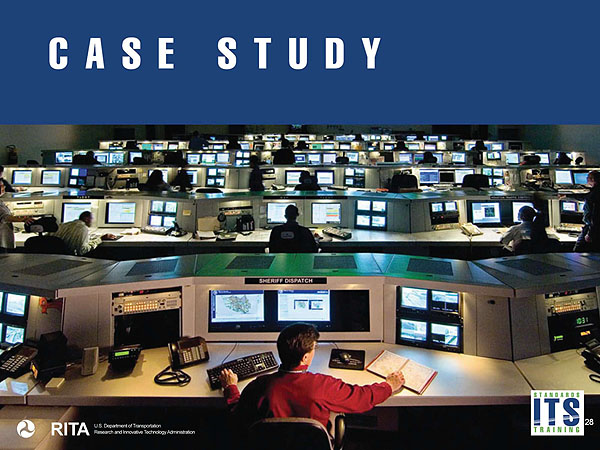
Slide 29:
Learning Objective #3
Case Study: NTCIP 1203 v03 - DMS
- SEP-based Standard Provides Test Cases and Test Procedures for Device Testing
- Case Study shows how to Create TDS and Select Correct Test Cases and Test Procedures
Slide 30:
Learning Objective #3
Case Study: NTCIP 1203 v03 - DMS
DMS Configuration:
- Character matrix
- Three lines by 18 characters
- Each character is 7 rows high by 5 columns wide
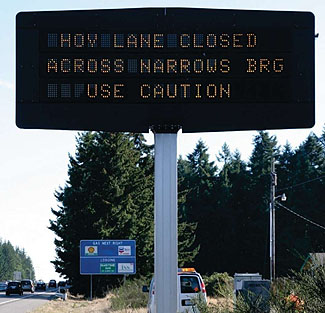
Courtesy: Intelligent Devices, Inc.
(Extended Text Description: Slide 30: To the right of the text a picture shows a large sign with a black background and amber characters. The top line begins with a blank character, after which “HOV LANE CLOSED” is followed by two blank characters. The middle line shows “ACROSS NARROWS BRG”. The bottom line has three blank characters followed by “USE CAUTION”, which is followed by four blank characters.)
Slide 31:
Learning Objective #3
Content of Test Design Specifications
Not included in NTCIP standards
- Test design specification identifier - must be unique
- Features to be tested - identify the test items and the specific features to be tested
- Approach refinements - include specific test techniques; summarize common attributes of any test cases
- Test identification - identify the test cases to be used
- Feature pass/fail criteria
Page 6 in the Supplement
Slide 32:
Learning Objective #3
Case Study: TDS for DMS
Selecting Features using PRL
- Features are selected by the specifying authority using the Protocol Requirements List in NTCIP 1203 v03.
- Functional Requirement "DMS Display Matrix Configuration" is Mandatory
NTCIP 1203 Protocol Requirements List (PRL)
|
USER NEED SECTION NUMBER |
USER NEED |
FR SECTION NUMBER |
FUNCTIONAL REQUIREMENT |
CONFORMANCE |
SUPPORT/ PROJECT REQUIREMENT |
ADDITIONAL PROJECT REQUIREMENTS |
|---|---|---|---|---|---|---|
|
2.3.2.3 |
DMS Display Matrix Configuration |
M |
Yes |
The DMS shall be 9,000 millimeters wide (0..65535) and 2,700 millimeters high (0..65535), inclusive of borders. The Sign's Border shall be at least 400 millimeters wide (0..65535) and 400 millimeters high (0..65535). |
||
|
2.3.2.3.1 |
Non-Matrix |
0.2 (1) |
Yes/No |
|||
|
2.3.2.3.2 (Matrix) |
Matrix |
0.2 (1) |
Yes/No |
The pitch between pixels shall be at least 66 millimeters (0..255). |
||
|
2.3.2.3.2.1 |
Full Matrix |
0.3 (1) |
Yes/No |
The sign shall be pixels wide (0..65535) and pixels high (0..65535). |
||
|
2.3.2.3.2.2 |
Line Matrix |
0.3 (1) |
Yes/No |
The sign shall have lines with each line being pixels wide and pixels high. |
||
|
2.3.2.3.2.3 |
Character Matrix |
0.3(1) |
Yes/No |
The sign shall be 18 characters wide and 3 characters high with each character being 5 pixels wide (0..255), 7 pixels high (0..255). |
||
(Additional Notes from the Author: Below the text, an excerpt from the NTCIP 1203 Protocol Requirements List (PRL) shows a table with the following columns: user Need Section Number, User Need, FR Section Number, Functional Requirement, Conformance, Support / Project Requirement and Additional Project Requirements. Entries for User Need 2.3.2.3 through 2.3.2.3.2.3 are shown. Under the Support / Project Requirement column, individual entries indicating “Yes/No” have had either Yes or No highlighted.)
Slide 33:
Learning Objective #3
Case Study: TDS for DMS
Selecting Features using PRL (Cont'd)
- O.# (range) means these options are part of an option group. Support of the number of items indicated by the "(range)" is required from all options labeled with the same numeral #.
NTCIP 1203 Protocol Requirements List (PRL)
|
USER NEED SECTION NUMBER |
USER NEED |
FR SECTION NUMBER |
FUNCTIONAL REQUIREMENT |
CONFORMANCE |
SUPPORT/ PROJECT REQUIREMENT |
ADDITIONAL PROJECT REQUIREMENTS |
|---|---|---|---|---|---|---|
2.3.2.3 |
DMS Display Matrix Configuration |
M |
Yes |
The DMS shall be 9,000 millimeters wide (0..65535) and 2,700 millimeters high (0..65535), inclusive of borders. The Sign's Border shall be at least 400 millimeters wide (0..65535) and 400 millimeters high (0..65535). |
||
2.3.2.3.1 |
Non-Matrix |
0.2 (1) |
Yes/No |
|||
2.3.2.3.2 (Matrix) |
Matrix |
0.2 (1) |
Yes/No |
The pitch between pixels shall be at least 66 millimeters (0..255). |
||
2.3.2.3.2.1 |
Full Matrix |
0.3 (1) |
Yes/No |
The sign shall be pixels wide (0..65535) and pixels high (0..65535). |
||
2.3.2.3.2.2 |
Line Matrix |
0.3 (1) |
Yes/No |
The sign shall have lines with each line being pixels wide and pixels high. |
||
2.3.2.3.2.3 |
Character Matrix |
0.3(1) |
Yes/No |
The sign shall be 18 characters wide and 3 characters high with each character being 5 pixels wide (0..255), 7 pixels high (0..255). |
||
(Additional Notes from the Author: Slide 33: Above, the PRL excerpt from slide 32 has been repeated.)
Slide 34:
Learning Objective #3
Case Study: TDS for DMS
Selecting Features using PRL (Cont'd)
- Because "Matrix" was selected, several requirements are mandatory, including the ones selected below.
NTCIP 1203 Protocol Requirements List (PRL)
|
USER NEED SECTION NUMBER |
USER NEED |
FR SECTION NUMBER |
FUNCTIONAL REQUIREMENT |
CONFORMANCE |
SUPPORT/ PROJECT REQUIREMENT |
ADDITIONAL PROJECT REQUIREMENTS |
|---|---|---|---|---|---|---|
|
2.5.1.2 |
Determine Sign Display Capabilities |
O |
Yes/No |
|||
|
3.5.1.2.1.1 |
Determine the Size of the Sign Face |
M |
Yes |
|||
|
3.5.1.2.1.2 |
Determine the Size of the Sign Border |
M |
Yes |
|||
|
3.5.1.2.1.3 |
Determine Beacon Type |
M |
Yes |
|||
|
3.5.1.2.1.4 |
Determine Sign Access and Legend |
M |
Yes |
|||
|
3.5.1.2.2.1 |
Determine Sign Face Size in Pixels |
Matrix:M |
Yes/NA |
|||
|
3.5.1.2.2.2 |
Determine Character Size in Pixels |
Matrix:M |
Yes/NA |
|||
|
3.5.1.2.2.3 |
Determine Pixel Spacing |
Matrix:M |
Yes/NA |
|||
(Additional Notes fror the Author: Above an excerpt from the NTCIP 1203 PRL shows a table with the same column headings as described in slide 32. The Entry for User Need Section Number 2.5.1.2, with FR Section Numbers 3.2.1.2.1.1 through 3.5.1.2.2.3, is shown. The first entry shows User Need Section Number 2.5.1.2, User Need “Determine Sign Display Capabilities”, Conformance “O”, and Support / Project Requirement “Yes / No”, with Yes highlighted. For the three requirements at the bottom of the table the Conformance column indicates “Matrix: M”, and the Support / Project Requirement column shows “Yes / NA”, with Yes highlighted.)
Slide 35:
Learning Objective #3
Test Design - Features to be Tested
Requirements Traceability Matrix (RTM)
- RTM maps Functional Requirements to Dialogs and Objects.
|
Requirements Traceability Matrix (RTM) |
|||||
|
FRID |
Functional Requirement |
Dialog ID |
Object ID |
Object Name |
Additional Specifications |
|---|---|---|---|---|---|
|
3.5.1.2.2 |
Determine Matrix Capabilities |
||||
|
3.5.1.2.2.1 |
Determine Sign Face Size in Pixels |
G.1 |
|||
|
5.3.3 |
vmsSignHeightPixels |
||||
|
5.3.4 |
vmsSignWidthPixels |
||||
|
3.5.1.2.2.2 |
Determine Character Size in Pixels |
G.1 |
|||
|
5.3.1 |
vmsCharacterHeightPixels |
||||
|
5.3.2 |
vmsCharacterWidth Pixels |
||||
|
3.5.1.2.2.3 |
Determine Pixel Spacing |
G.1 |
|||
|
5.3.5 |
vmsHorizontalPitch |
||||
|
5.3.6 |
vmsVertical Pitch |
||||
(Additional Notes from the Author: Slide 35: This is an excerpt from the NTCIP 1203 Requirements Traceability Matrix shows a table with the following column headings: FR ID, Functional Requirement, Dialog ID, Object ID, Object Name, and Additional Specifications.)
Slide 36:
Learning Objective #3
Test Design - Test Identification
Using RTCTM to Select Test Cases
- RTCTM links a Functional Requirement to one or more test cases
- All test cases referenced must be performed to verify conformance.
Table 1. Requirements to Test Case Traceability Table
|
Requirement |
Test Case |
||
|---|---|---|---|
|
ID |
Title |
ID |
Title |
|
3.5.1.2.2 |
Determine Matrix Capabilities |
||
|
3.5.1.2.2.1 |
Determine Sign Face Size in Pixels |
||
|
C.3.1.6 |
Determine Sign Face Size in Pixels |
||
|
3.5.1.2.2.2 |
Determine Character Size in Pixels |
||
|
C.3.1.7 |
Determine Character Size in Pixels |
||
|
3.5.1.2.2.3 |
Determine Pixel Spacing |
||
|
C.3.1.8 |
Determine Pixel Spacing |
||
(Additional Notes from the Author: Slide 376: This is an excerpt from the NTCIP 1203 Requirements to Test Case Traceability Matrix shows a table with the following top level column headings: Requirement and Test Case. Below Requirement are two column subheadings: ID and Title. Below Test Case are two column subheadings: ID and Title. The Requirement ID 3.5.1.2.2.1 is highlighted, which has the title “Determine Sign Face Size in Pixels”.)
Slide 37:
Learning Objective #3
Test Case Specifications (TCS)
TCS - A document specifying inputs, predicted results, and a set of execution conditions for a test item.
- Test Case Specification Identifier
- Purpose
- Test Items
- Input Specifications
- Output Specifications
- Environmental Needs
- Special Procedural Requirements
- Intercase Dependencies
Pages 7-9 in the Supplement
Slide 38:
Learning Objective #3
Test Case Specifications
Inputs from PRL
- The individual test cases are provided with Test Case IDs, each of which defines the required inputs, and references the associated NTCIP 1203 Test Procedures.
|
NTCIP 1203 Test Case / Test Procedure ID |
Test Case / Test Procedure |
Selected |
Variable |
Reference |
Value |
|---|---|---|---|---|---|
|
1.6 |
Determine Sign Face Size in Pixels |
X |
Required_Sign_Pixel_Height |
PRL 2.3.2.3.2.1 - 2.3.2.3.2.3. |
21 |
|
Required_Sign_Pixel_Width |
PRL 2.3.2.3.2.1-2.3.2.3.2.3 |
90 |
|||
|
1.7 |
Determine Character Size in Pixels |
X |
Required_Character_Pixel_Height |
PRL 2.3.2.3.2.3 |
7 |
|
Required_Character_Pixel_Width |
PRL 2.3.2.3.2.3 |
5 |
|||
|
1.3 |
Determine Pixel Spacing |
X |
Required_Horizontal_Pitch |
PRL 2.3.2.3.2 |
66 (mm) |
|
Required_Vertical_Pitch |
PRL 2.3.2.3.2 |
66 (mm) |
(Additional Notes from the Author: Slide 38: Below the text, an excerpt from the Student Supplement of the Test Case Specifications created for this webinar shows a table with the following top level column headings: NTCIP 1203 Test Case / Test Procedure ID; Test Case / Test Procedure; Selected; Variable; Reference; and Value. The first entry is highlighted, showing that Test Case / Test Procedure ID 1.6, Determine Sign Face Size in Pixels, was selected (has an X in column “Selected”), and has two variables: Required_Sign_Pixel_Height and Required_Sign_Pixel_Width. References to the PRL are shown for each variable, and the values 21 and 90, respectively, are assigned.)
Slide 39:
Learning Objective #3
Test Case Specifications
Example NTCIP Test Case/Test Procedure
- NTCIP combines Test Cases and Test Procedures as shown below, which does not strictly follow IEEE 829.
C.3.1.6 Determine Sign Face Size in Pixels
|
Test |
Title: |
Determine Sign Face Size in Pixels |
|
|---|---|---|---|
|
Case: 1.6 |
Description: |
This test case verifies that the DMS indicates that it has a height and width in pixels that meet the requirements of the specifications. |
|
|
Variables: |
Required_Sign_Pixel_Height |
PRL 2.3.2.3.2.1-2.3.2.3.2.3 |
|
|
Required_Sign_Pixel_Width |
PRL 2.3.2.3.2.1-2.3.2.3.2.3 |
||
|
Pass/Fail Criteria: |
The DUT shall pass every verification step included within the Test Case to pass the Test Case. |
||
|
Step |
Test Procedure |
Results Additional References |
|---|---|---|
|
1 |
CONFIGURE: Determine the sign height in pixels as required by the specification (PRL 2.3.2.3.2.1-2.3.2.3.2.3). RECORD this information as: |
Slide 40:
Learning Objective #3
Test Procedure Specification (TPS)
- TPS - A document specifying a sequence of actions for the execution of a test.
- Standard test procedures ensure that the conformance testing is performed in the same manner on separate test occasions.
- It is important not to skip any steps in the Test Procedures to ensure proper conformance testing.
See Supplement
Slide 41:
Learning Objective #3
Test Procedures
Per the IEEE 829 definition, the Test Procedure only defines the steps necessary to test the feature.
|
Step |
Test Procedure |
Results |
Additional References |
|---|---|---|---|
|
1 |
CONFIGURE: Determine ttie sign height in pixels as required by the specification (PRL2.3.2.3.2.1-2.3.2.32.3}. RECORD this information as: »Required_Sign_Pixel_Height |
||
|
2 |
CONFIGURE: D etermin e tti e s ign width in pixels as required by Die specification (PRL2.3.2.3.2.1-2.3.2.32.3}. RECORD this information as: »Required_Sign_Pixel_Width |
||
|
3 |
SET-UP: Determine the actual sign height in pixels. RECORD this information as: »Actual_Pixel_Height |
||
|
4 |
SET-UP: Determine the actual sign width in pixels. RECORD this information as: »Actual_Pixel_Width |
||
|
5 |
GET the following objects): »vmsSignHeightPixels .0 »vmsSignWidthPixels .0 |
Pass /Fail (Section 3.5.1.2.2.1} |
|
|
6 |
VERIFY tti at tti e RESPONSE VALUE for vmsSignHeightPixels. 0 is equal to Required_Sign_Pixel_Height. |
Pass IFail (PRL 2.3.2.3.2.12.3.2.3.2.3} |
|
|
7 |
VERIFY that the RESPONSE VALUE for vmsSignWidthPixels.0 is equal to Required_Sign_Pixel_Width. |
Pass iFail (PRL 2.3.2.3.2.12.3.2.3.2.3} |
|
|
8 |
VERIFY that the RESPONSE VALUE for vmsSignHeightPixels.O is equal to Actual_Pixel_Height. |
Pass 1 Fail (Section 3.5.1.2.2.1} |
|
|
9 |
VERIFYthat the RESPONSE VALUE for vmsSignWidthPixels.0 is equal to Actual_Pixel_Width. |
Pass 1 Fail (Section 3.5.1.2.2.1} |
Page 10 in the Supplement
(Additional Notes from the Author: Slide 41: To the right of the text, an excerpt from NTCIP 1203 Test Case / Test Procedure 1.6 shows a table with the steps to be performed, with the following column headings: Step; Test Procedure; Results; and Additional References.)
Slide 42:
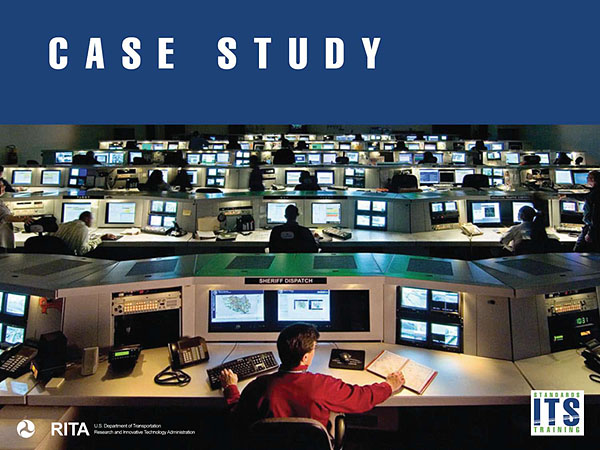
Slide 43:
Learning Objective #3
Case Study: NTCIP 1209 v02 - TSS
- Transportation Sensor Systems (TSS) are used to monitor vehicle volume, occupancy and speed over a selectable period of time.
- SEP-based Standard has PRL and Dialogs, but no Test Cases or Test Procedures
- Test Design Specifications can be created as shown in the previous DMS Case Study.
- This Case Study shows how to create Test Cases and Test Procedures
Pages 11-12 in the Supplement
Slide 44:
Learning Objective #3
TSS Case Study: PRL and RTM
3.2.8 Protocol Requirements List (PRL) Table
|
User Need Section Number |
User Need |
FR Section Number |
Functional Requirement |
Conformance |
Support / Project Requirement |
Additional Specifications |
|---|---|---|---|---|---|---|
|
2.5.2.1 |
Reset the TSS |
|||||
|
3.4.1.3.1 |
Restart the TSS |
M |
Yes |
|||
|
3.4.1.3.2 |
Reinitialize User Settings |
M |
Yes |
|||
|
3.4.1.3.3 |
Restore Factory Defaults |
M |
Yes |
|||
|
3.4.1.3.4 |
Retune |
M |
Yes |
|||
|
3.4.1.3.8 |
Execute Pending Configuration |
O.1 |
Yes/No |
|||
|
3.4.1.3.9 |
Abort Pending Configuration |
O.1 |
Yes/No |
|||
|
3.4.1.3.10 |
Validate Pending Configuration |
O.1 |
Yes/No |
|||
REQUIREMENTS TRACEABILITY MATRIX (RTM)
|
Requirement ID |
Requirement |
Dialog ID |
Dialog |
Object ID |
Object |
|---|---|---|---|---|---|
|
3.4.1.3 |
Control the TSS |
||||
|
3.4.1.3.1 |
Restart the TSS |
||||
|
4.3.1.1 |
Reset and Synchronize the TSS |
||||
|
5.2.1 |
sensorSystem Reset |
||||
|
5.2.2 |
sensorSystemStatus |
||||
Pages 11-12 in the Supplement
(Additional Notes from the Author: Slide 44: Above, an excerpt from NTCIP 1209 Protocol Requirements List a table is shown with the same column headings as described for slide 32. The first row shows User Need Section Number “2.5.2.1” with User Need “Reset the TSS”. The second row shows FR Section Number “3.4.1.3.1” with Functional Requirement “Restart the TSS”, Conformance “M” and Support / Project Requirement “Yes”.
Below the PRL excerpt is an excerpt from the NTCIP 1209 Requirements Traceability Matrix, with column headings Requirement ID, Requirement, Dialog ID, Dialog, Object ID, and Object, and showing Requirement ID 3.4.1.3 and 3.4.1.3.1 – Restart the TSS.)
Slide 45:
Learning Objective #3
TSS Case Study - Dialog
4.3.1.1 Reset and Synchronize the TSS
The standardized dialog for a management station to restart, reinitialize, restore, retune, re-sync, run short diagnostics or long diagnostics of a TSS shall be as follows:
- (Precondition) None
- The management station shall GET the sensorSystemStatus.x state. If the state of sensorSystemStatus is 'initializing', 'pendingConfigurationChange', or ValidatingPendingConfiguration', then the management station shall abort the process
- The management station shall SET the sensorSystemReset.y state to 'restart', 'reinitializeUserSettings', 'restoreFactoryDefaults', 'retune', 'resyncSamplingPeriods', 'shortDiagnostics', or 'fullDiagnostics'
- The management station shall GET the sensorSystemStatus.x state
- If the management station gets no response, then repeat Step d up to maximum TSS initialization time
- If the sensorSystemStatus.x state is 'initializing', then repeat Step d
- If sensorSystemStatus.x state is 'oK', then the TSS reset is complete
- If sensorSystemStatus.x state NOT 'oK', then the reset may not have completed, did not complete normally, or an error was encountered during the process. The management station shall abort the process
Pages 11-12 in the Supplement
(Additional Notes from the Author: Slide 45: This is an excerpt from NTCIP 1209 Dialogs shows the dialog for 4.3.1.1 – Reset and Synchronize the TSS.)
Slide 46:
Learning Objective #3
TSS Case Study - Test Case Specification
- From the Dialog, only one parameter need be passed to the Test Procedure - the command
- The result should be sensorSystemStatus.0 = oK
|
Test Case Number |
Test Case Name |
Test Procedure |
Object(s) Under Test Variables |
Result |
|---|---|---|---|---|
|
TC1205-001 |
Restart TSS |
TP1205-001 |
sensorSystemStatus.0, Reset_Command = sensorSystemReset.O 'restart' |
sensorSystemStatus. 0 = oK |
Pages 11-12 in the Supplement
(Additional Notes from the Author: Above, an excerpt from the Student Supplement of the Test Case Specification created for this webinar shows a table with a single entry, where Test Case Number is TC1205-001, Test Case Name is Restart TSS, Test Procedure is TP1205-001, Object(s) Under Test are sensorSystemStatus.0 and sensorSystemReset.0, variables are Reset_Command = ‘restart’, and Result is sensorSystemStatus.0 = oK.)
Slide 47:
Learning Objective #3
TSS Case Study - Test Procedure
|
Test Procedure: TP1209-001 |
Title: Reset the TSS
Description: This Test Case verifies that the operator can correctly reset the
TSS. Pass/Fail Criteria: The DUT shall pass every verification step included within the Test Case in order to pass the Test Case Variables: Reset_Command Command to be implemented |
|
|
Test Step Number |
Test Step |
Results |
|---|---|---|
|
1 |
GET sensorSystemStatus G |
Pass / Fail |
|
2. |
IF the RESPONSE VALUE to sensorSystemStatus 0 is Initializing', pending Configuration Change', or validatingPendingConfiguration' EXIT the Test Procedure, and correct the deficiency before restarting the test |
|
|
3 |
SET sensorSystemReset.0 to ResetCommand |
Pass / Fail |
|
4. |
GET sensorSystemStatus.0 |
Pass / Fail |
|
5. |
IF the RESPONSE VALUE for sensorSystemStatus 0 equals 'initializing', then GOTO Step 4 NOTE-If the RESPONSE VALUE remains at Initializing'for more than the maximum TSS initialization time, this test fails |
Pass / Fail |
|
6. |
VERIFY that the RESPONSE VALUE for sensorSystemStatus.0 equals oK' |
Pass / Fail |
Page 13 in the Supplement
(Additional Notes from the Author: Slide 47: This is an excerpt from the Student Supplement of the Test Procedure Specification created for this webinar shows Test Procedure ID TP1209-001 as captured from the Student Supplement.)
Slide 48:

Slide 49:
Learning Objective #3
According to IEEE 829, which of the following are included in Test Procedures?
- Inputs
- Execution conditions
- Steps to execute
- Expected results
- All of the above
Slide 50:
Learning Objective #4
Standards developed without SEP
- NO User Needs, Functional Requirements, or PRLs.
- Test Design Specifications, Test Cases, and Test Procedures must be generated by the specifying authority.
Slide 51:
Learning Objective #4
Conformance Groups
Purpose
- Used by NTCIP standards that were not created using SEP
- Combine objects that are similar
- Define whether groups of objects are mandatory or optional
- Can be used to specify requirements and generate Test Specifications.
Slide 52:
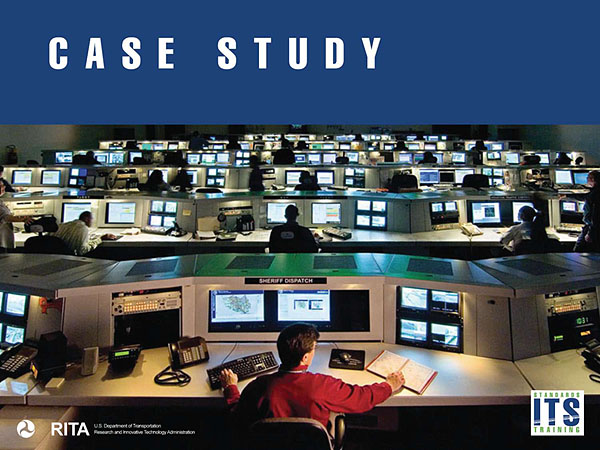
Slide 53:
Learning Objective #4
NTCIP 1205 CCTV Example
- NTCIP 1205, Cameras, was not created using SEP
- No PRL
- No Test Cases or Test Procedures
- Conformance Groups are used instead

Photo by Kent Flemmer, Flemmer Photography
(Extended Text Description: Slide 53: To the right of the text is a picture. In the background is a city skyline. A freeway leads from the city out of frame lower-right. A pan-tilt-zoom camera is shown on the left aimed at the freeway.)
Slide 54:
Learning Objective #4
Conformance Groups
Mandatory and Optional Groups
- CCTV Configuration Conformance Group is Mandatory.
- CCTV Motion Control Conformance Group is Optional, but is selected as being Supported.
Table 4-2: Conformance Statement Table
|
Conformance Group |
Reference |
Conformance Requirement |
|---|---|---|
|
Configuration |
NTCIP 1201:1996 |
mandatory |
|
Database Management |
NTCIP 1201:1996, Amendment 1 |
optional |
|
Time Management |
NTCIP 1201:1996, Amendment 1 |
optional |
|
CCTV Configuration |
NTCIP 1205 |
mandatory |
|
Extended Functions |
NTCIP 1205 |
optional |
|
Motion Control |
NTCIP 1205 |
optional |
|
On-Screen Menu Control |
NTCIP 1205 |
optional |
(Additional Notes from the Author: Slide 54: Above, an excerpt from NTCIP 1205 showing Table 4-2: Conformance Statement Table.)
Slide 55:
Learning Objective #4
NTCIP 1205 CCTV Example
Test Design Specification
- Excerpts from two Conformance Groups show the Mandatory objects for the Zoom feature.
4.1.1 CCTV Configuration Conformance Group
|
Object or Table Name |
Reference |
Conformance Requirement Within the group |
|---|---|---|
|
rangeZoom Limit |
NTCIP 1205 |
mandatory |
|
timeoutZoom |
NTCIP 1205 |
mandatory |
4.1.3 Motion Control Conformance Group
|
Object or Table Name |
Reference |
Conformance Requirement Within the group |
|---|---|---|
|
positionZoomLens |
NTCIP 1205 |
mandatory |
(Additional Notes from the Author: Slide 55: These are two excerpts from NTCIP 1205. The first, from table 4.1.1 – CCTV Configuration Conformance Group, shows the objects rangeZoomLimit and timeoutZoom. The second from table 4.1.3 – Motion Control Conformance Group, shows the object positionZoomLens.)
Slide 56:
Learning Objective #4
NTCIP 1205 CCTV Example
Test Design Specification
- positionZoomLens - allows the Central to command the camera to change its zoom setting
- rangeZoomLimit - defines the maximum zoom level
- timeoutZoom - limits how long a zoom can continue
Slide 57:
Learning Objective #4
NTCIP 1205 CCTV Example
Test Cases
- Excerpt from a TCS showing three of the Test Cases required to show conformance for the Zoom feature.
Appendix A:
|
Test Case Number |
Test Case Name |
Test Procedure Steps |
Object(s) Under Test |
Variables |
Result |
|---|---|---|---|---|---|
|
TC1205-001 |
Zoom absolute - maximum telephoto |
TP1205-003 Steps 4-10 |
positionZoomLens.0 |
Mode = 2 (absolute) Speed_Tele_Fast = 127 Offset = rangeZoomLimit.0 |
Camera should zoom to its maximum setting at its maximum speed |
|
TC1205-007 |
Zoom past rangeZoomLimit.O |
TP1205-003 Steps 39-41 |
positionZoomLens.0; rangeZoomLimit.0 |
Mode = 1 (absolute) Speed_Tele_Fast = 127 Offset = 65535 |
Response Error is badValue |
|
TC1205-008 |
Zoom for greater duration than timeoutZoom.0 |
TP1205-003 Steps 40-46 |
positionZoomLens.0; timeoutZoom.0 |
Mode = 3 (continuous) Speed Tele Slow = 10 Offset = rangeZoomLimit.0 |
Camera begins zooming toward its maximum telephoto setting, but stops after Zoom_Timeout seconds |
Pages 14-16 in the Supplement
(Additional Notes from the Author: Slide 57: This is an excerpt from the Student Supplement Appendix A showing TC1205-001, TC1205-007 and TC1205-008.)
Slide 58:
Learning Objective #4
NTCIP 1205 CCTV Example
Test Procedures
- Excerpt from the TPS for the Zoom feature
- Referenced by TC1205-001: Zoom Absolute -Maximum Telephoto
- Causes the camera to zoom in to its zoom limit
|
Test Procedure: TP1205-003 |
Title: Zoom Camera
Description: This Test Case verifies that 1lie operator can correctly zoom the camera in and out |
|
|
Test Step Number |
Test Step |
Results |
|---|---|---|
|
1. |
Get rangeZoomLimit .O |
Pass / Fail |
|
2. |
RECORD this integer value and its two-byte hex value as: » ZoomLimit » ZoomJJmrMHex |
|
|
3. |
Set timeoutZoom.0 to 0: turning off this feature. |
Pass / Fail |
|
4. |
Set positionZoomLens.0 to |
Pass / Fail |
|
5. |
Delay for 10 seconds |
|
|
6. |
Verify that the camera zoomed to its absolute telephoto position. |
Pass / Fail |
|
7. |
Get positionZoomLens.O |
Pass / Fail |
|
8. |
Verify that the Response Value equals Mode: 02 Speed: Speed_Tele_Fast Position or Offset: Zoom_Limit_Hex |
Pass / Fail |
|
9. |
Get positionQueryZoom.O |
Pass / Fail |
|
10. |
Verify that the Response Value equals ZoomLimit. A Response Error of noSuchName indicates that positionQueryZoom.0 is unsupported. |
Pass / Fail / Pass Unsupported |
Pages 17-19 in the Supplement
(Additional Notes from the Author: Slide 58: This table is an excerpt from the Student Supplement showing TP1205-003, a Test Procedure created for this webinar.)
Slide 59:
Learning Objective #4
Additional Test Documents
These are used in addition to the Test Plan and Test Specifications.
- A Test Item Transmittal is used to document transferring a test item between entities, and includes its status.
- Test Incident Reports provide a means of recording anomalies that occurred during the testing.
- The Test Summary is typically a one-page report providing the results of the testing.
- Test Logs document the testing that occurred.
Slide 60:
Learning Objectives
1. Describe, within the context of the testing lifecycle, the role of Test Plans, Test Design Specifications, Test Cases, and Test Procedures
2. Describe the purpose and content of Test Design Specifications, Test Cases, and Test Procedures
Slide 61:
Learning Objectives (Cont'd)
3. For standards using Systems Engineering Process (SEP), detail the manner that Protocol Requirements Lists (PRLs) and Requirements to Test Cases Traceability Matrices (RTCTMs) can be used to create Test Specifications
4. For standards that do not use SEP, detail the manner that Conformance Groups can be used to create Test Specifications
Slide 62:

Slide 63:
What Did We Learn Today?
- The Test Plan is created early in the Project Life Cycle, and defines the testing to be performed from a management-level perspective.
- Test Design Specifications detail the testing to be performed.
- Test Cases define the inputs , expected results, and test conditions.
- Test Procedures define the steps to be performed to execute the tests.
- PRL and RTM are two items found in standards created using SEP.
- Conformance Groups are found in standards created without using SEP.
For More Information
- Systems Engineering Guidebook for Intelligent Transportation Systems Version 3.0 (The "V" Systems Engineering Model) (http://ops.fhwa.dot.gov/publications/seitsguide/seguide.pdf)
- IEEE Std 829-1998 - IEEE Standard for Software Test Documentation
- NTCIP 1204 Version v03.08, National Transportation Communications for ITS Protocol, Object Definitions for Environmental Sensor Stations (ESS) (www.ntcip.org)
- NTCIP 1201 Version v03.13a, National Transportation Communications for ITS Protocol, Global Object Definitions (www.ntcip.org)
- NTCIP 8007 Version 1.21, National Transportation Communications for ITS Protocol, Testing and CA Documentation within NTCIP Standards (www.ntcip.org)
- NTCIP 9001 Version v04, National Transportation Communications for ITS Protocol, The NTCIP Guide (www.ntcip.org)
Slide 65:
Curriculum Path (Testing)
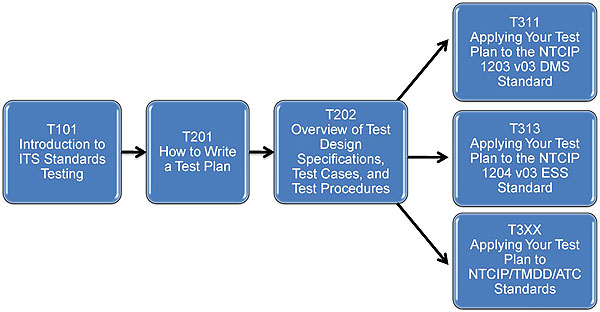
(Extended Text Description: Slide 65: Curriculum Path (Testing): A graphical illustration indicating the sequence of training modules for the standards that include Testing content. Each module is represented by a box with the name of the module in it and an arrow showing the logical flow of the modules. The first box is labeled “T101 Introduction to ITS Standards Testing.” An arrow from this box connects it to a box labeled “T201 How to Write a Test Plan”. An arrow from this box connects it to a box labeled “T202 Overview of Test Design Specifications, Test Cases, and Test Procedures”. Three arrows from this box connect to three additional boxes labeled “T311 Applying Your Test Plan to the NTCIP 1203 v03 DMS Standard”, “T313 Applying Your Test Plan to the NTCIP 1204 v03 ESS Standard”, and “T3XX Applying Your Test Plan to NTCIP/TMDD/ATC Standards”.)
Slide 66:
